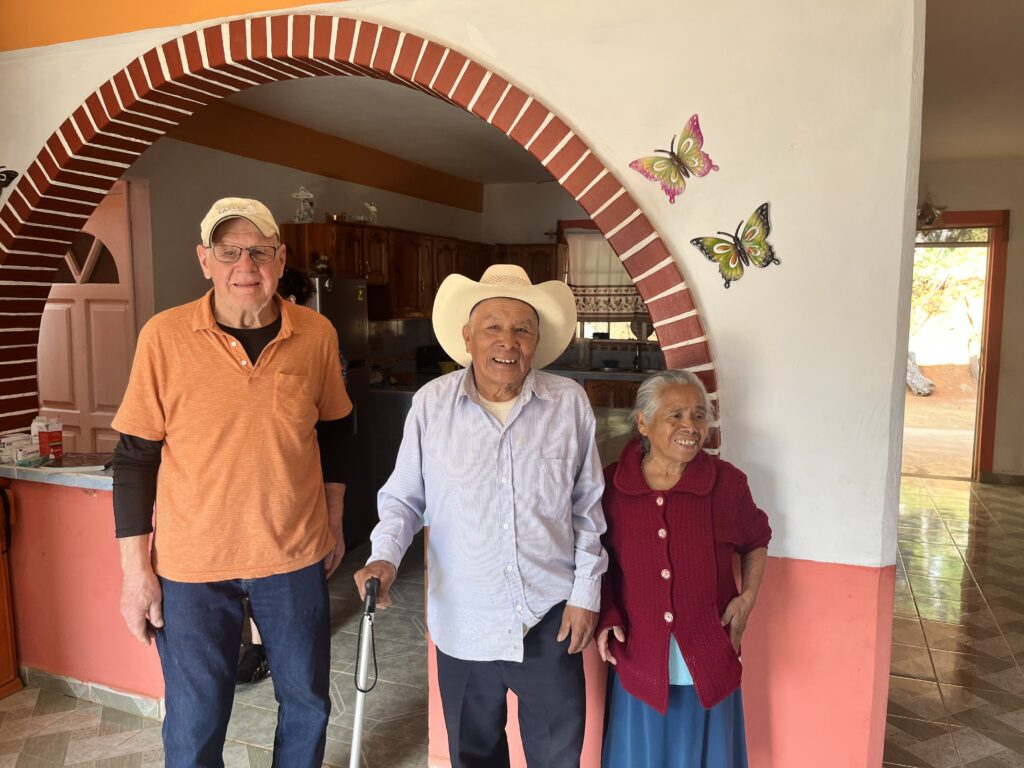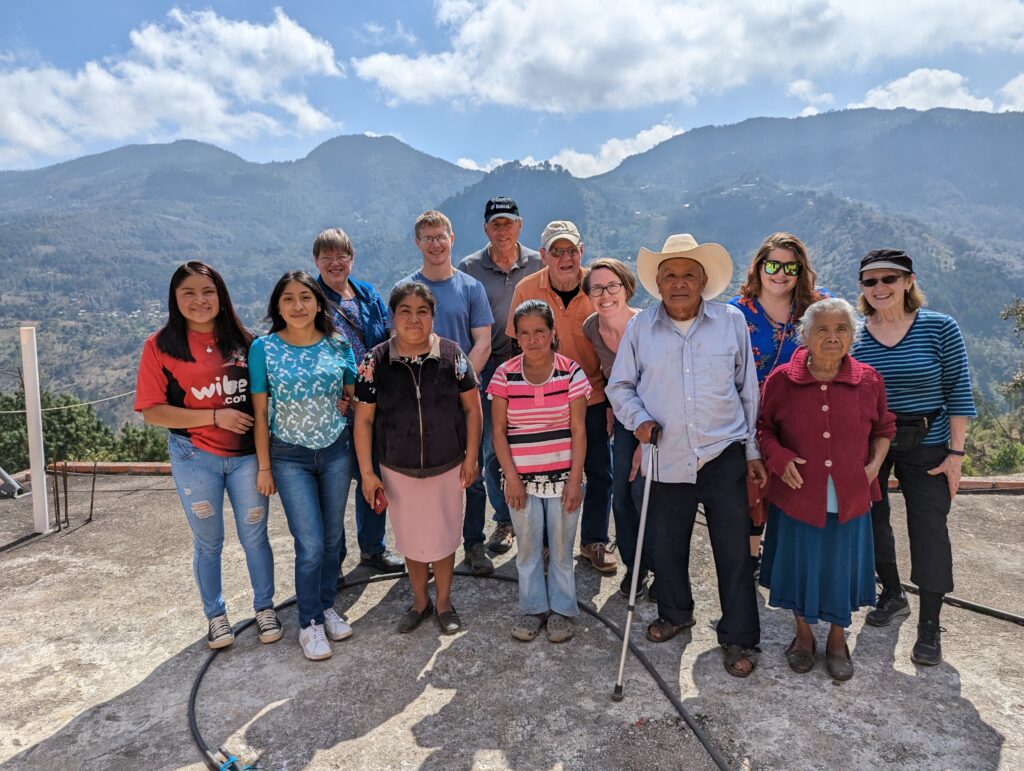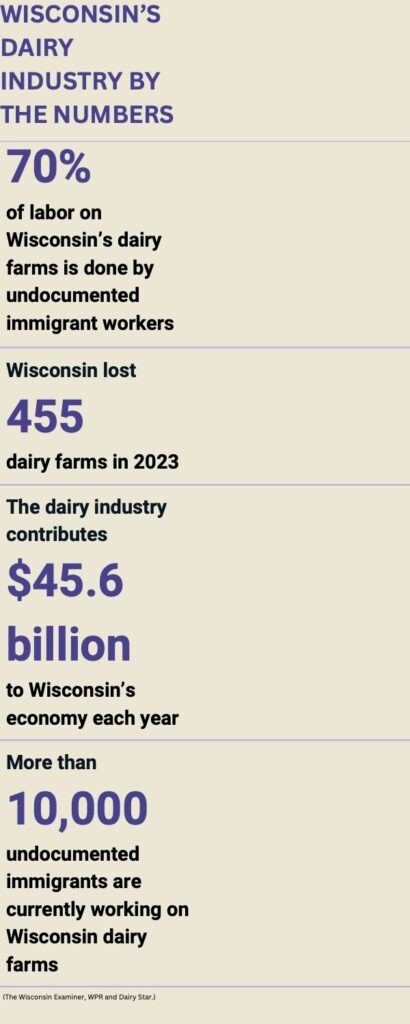It’s a typical summer day: rays of sun fall onto Roberto Tecpile’s outstretched arm as he unloads golf clubs from his car.
Casually strolling towards the main clubhouse, he’s with his boss, John Rosenow. Other golfers wave hello familiarly as they pass by the pair, calling both men by their first names.
Although Tecpile might appear as a vetted community member, much of his life has been in his home town in Mexico. An immigrant who works for Rosenow on his dairy farm in Cochrane, a small town in western Wisconsin, Tecpile started working in the United States in the late ’90s.
In 1998, Rosenow couldn’t find anyone to work on his dairy farm, and reluctantly, he hired his first Mexican employee. Rosenow didn’t speak Spanish, was unfamiliar with Mexican culture and frankly, he said, he was scared of it.
Rosenow’s hesitation to hire Mexican employees came from a fear of the unknown that started to dissipate once he started getting to know his Mexican employees on a personal level, Rosenow says.
“If they had these kinds of jobs for this kind of pay in Mexico, they would not be up here. “
Now, 13 out of 18 of his dairy farmers are Mexican. He has visited his employees’ hometowns in Mexico at least 10 times through Puentes/Bridges, a nonprofit organization he co-founded in 2003.
Immigrant labor is the backbone of the Wisconsin dairy industry. Current political pressure could restrict immigration and change the way immigrant labor is used in the United States. But in Wisconsin, dairy farmers are working to understand their immigrant employees on a personal level and value what they bring to the state and to their businesses.
The survival of the Wisconsin dairy industry depends on illuminating the importance of immigrant labor and elevating cultural understanding between local community members and immigrants who work on their dairy farms.
“It’s a person that wants to get ahead in life, that’s hard working, honest. They may eat something different. They may look different. Maybe their skin is a different color, and they maybe have some cultural customs that we’re not used to, but they aren’t very different,” Rosenow says.

Undocumented immigrant workers perform 70% of labor on Wisconsin’s dairy farms, according to the Wisconsin Examiner, a nonpartisan, nonprofit newsite in Madison. Undocumented immigrant workers are a major factor in why the dairy industry contributes $45.7 billion to Wisconsin’s economy each year, according to a report from UW–Madison economics Professor Steve Deller.
Immigration is not only a central issue of the 2024 U.S. presidential election, but it’s also one fueled by intense rhetoric. Fifty-four percent of American voters said immigration was one of the election’s most important issues, according to an August 2024 Economist/YouGov poll. At a Sept. 28 campaign event in Prairie du Chien, a rural community in western Wisconsin, Donald Trump harshly characterized immigrants as “stone-cold killers,” “monsters” and “vile animals,” according to the Guardian.
But those who are closer to the issue say immigrant labor is essential to the survival of their business, and getting to know immigrants on a personal level has helped dissipate misguided, preconceived notions of immigrants in the United States.
“If you get a chance to know them, and perhaps just learn about where they come from, what they are trying to do for the families, that breaks down many barriers. “
As immigration becomes an increasingly polarized issue, Puentes/Bridges’ central goal of nonpartisan connection is more important than ever.
Using both the Spanish word for bridges, puentes, next to its English translation, the organization’s central focus is building a bridge between farmers in west central Wisconsin and southeastern Minnesota, Mexican immigrant workers and the communities in which they live.
Forging an innovative path forward for Wisconsin community members of all political affiliations to understand immigrants on a personal level, Puentes/Bridges focuses the lens on cultural understanding instead of politics.
“It’s an organization that tries to go past all the rhetoric [and] is nonpolitical,” Rosenow says. “All we are doing is trying to teach cultural awareness and understanding between two groups of people. And it has drawn a lot of attention — for some reason or another, we are the only ones that do that.”
One of the most impactful ways to foster cultural understanding between immigrants and dairy farmers is by showing rather than telling, according to Lori Miller, a Puentes/Bridges board member.
“People are just so polarized about everything,” Miller says. “It’s become very political. So making speeches, you know, isn’t always really a way to do it. I think it’s the philosophy of showing people.”
The impact of showing versus telling is why Puentes/Bridges chooses to increase cultural understanding through immersion opportunities. Over the past two decades, Puentes/Bridges has taken more than 150 farmers, educators and more to Mexico to better understand the lives and culture of Mexican immigrants.
From taking Spanish classes in Mexico to meeting the families of immigrants themselves, Puentes/Bridges’s trips provide a window into immigrants’ lives before they moved to the United States.
What their employees go through at home in Mexico doesn’t sink in for many Wisconsin dairy farmers until they see it themselves, says Mercedes Falk, director of Puentes/Bridges.

Walking across a village’s rough terrain with their own two feet, seeing how their employees once learned to farm by hand and empathizing with the difficulties of harvesting wood and carrying it on their own backs gives Wisconsin dairy farmers a newfound sense of respect, according to Falk.
Most of the workers come from what Americans would see as abject poverty, living in homes with dirt floors and no doors, according to Rosenow.
“So everyone’s future was to do this same thing as his ancestors had done,” Rosenow says. “And there really was not much hope. There was no place to get a job or do something different.”
For Tecpile, dreaming of a better life is a core part of who he is.
“Soy un soñador y quiero llegar lejos, quiero lo más que pueda cuando tenga ochenta años, y puedo hablar a muchas personas” [I am a dreamer. I want to go far, I want the most I can have when I am 80 years old. I want to talk to many people], Tecpile said in an interview conducted in Spanish.
Seeing immigrants as only workers and nothing more is what Tecpile imagines most Americans assume when they think of him or another immigrant worker.
Traveling the world, meeting as many people as he can and engaging in as many conversations as he can is his personal dream, Tecpile says. Unlike most Americans, however, he can’t travel freely.
“Ellos viven normal, no piensan de pueden ir a un país, y lo pueden regresar, ellos tienen libertad. Eso es lo bonito” [They live normally, they do not think if they can go to a country and if they can come back. They have liberty. This is a beautiful thing], Tecpile says.

There is generally a lack of understanding of the complications around the immigration system, and many immigrants are providing necessary labor in the United States, Falk says.
“The family farm of yesterday, where there were children who were going to continue the tradition and farm…that’s not around as much as it used to be,” Miller says.
The main reason Mexicans immigrate to the United States is to improve their economic situation, according to the Center for Strategic and International Studies, a think tank based in Washington, D.C.
What many people don’t understand is how few opportunities there are in Mexico for those immigrants who ultimately come to the United States for work, Falk says.
Some workers come from families where there is no money to send their kids to school beyond primary school, no resources to build a house beyond wooden walls and dirt floors and very few opportunities to get a job that can earn them enough money to do more than feed their families, Falk says. However, since the economy is changing, this is true of mostly men who are now in their 30s, 40s and 50s, and younger people are more likely to come from better situations, she says.
“If they had these kinds of jobs for this kind of pay in Mexico, they would not be up here,” Miller says.
One of Rosenow’s employees, Roberto Montalvo, is a local celebrity at his village in Mexico because he has helped numerous community members get jobs in the United States.
“He got elected to the county government and got a county truck to drive around in,” Rosenow says. “I was down there riding with him in his truck, and he would see somebody on the road and beep the horn and wave like a politician.”
The opportunities of the United States come with a price, however. Living away from home is extremely difficult for many immigrants, and some do not see their families for a decade, according to Miller.
“Es muy difícil. Cuando uno quiere vivir cerca de la familia, pero, por el paso está muy difícil para cruzar, entonces, quisiera quedarme un poco tiempo más, un año más, para juntar más dinero.” [It’s very difficult. When you want to live close to your family, but because the crossing is very difficult to cross the border. So I would rather stay for a while longer, one more year or so, to save up more money], Tecpile but because of the crossing, it’s very difficult to cross the border,” says.
Fear of deportation and cost barriers stop many Mexican workers from traveling home to see their families, according to Tecpile.
“If you get a chance to know them, and perhaps just learn about where they come from, what they are trying to do for the families, that breaks down many barriers,” Falk says.
The most important thing for the average community member to do is to acknowledge immigrants as part of the community, Miller says.
“It can just be a very brief, some kind of a friendly acknowledgement,” Miller says. “If you are out in the community, say hey, I see you. I think just even that, in and of itself, you know, is a nice step. So it’s nothing big. You do not have to even say anything.”
Cover Photo: A Puentes Bridges group visiting the families of their farmers in Las Palmas, Hidalgo, Mexico. Photo courtesy of Puentes Bridges.
Tile Photo: Photo courtesy of Puentes Bridges. A group from Puentes Bridges in Acatitla, Veracruz, Mexico, planting corn with Severo’s family, who has worked at John Rosenow’s farm on and off for 25 years.
Graphic by Cate Tarr.
Published Dec. 9, 2024